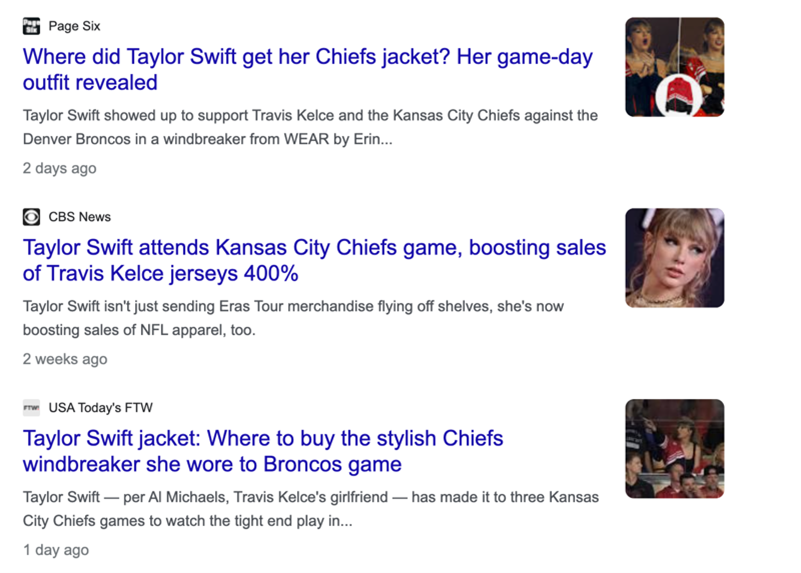The Experience Era: How AI Can Turn Staff into Swifties
Thursday October 19th, 2023
Estimated time to read: 4 minutes

Let’s talk about Taylor Swift. The entertainer has monopolized headlines, made economies stronger and merged football fans with Taylor Swift fans (Swifties). Who would have thought? AI likely could have predicted it – maybe not the relationship (although…maybe?) but definitely the impact of dating Kansas City Chiefs Tight End Travis Kelce. Hang out for a bit and we’ll tie this back to you – an HR, benefits or payroll professional – to ultimately show how AI can support you and better engage your teams based on this model.
This is because when the Swift-Kelce relationship (i.e., Swelce) was seemingly confirmed (when Swift attended his game with some famous pals), AI no doubt went to work all while the owners of AI-enabled advertising and marketing technology, simply watched the game with the rest of us or focused their efforts elsewhere. With AI working in the background, they didn’t miss out on a huge opportunity should they operate in areas like fan apparel or tickets. AI provides prescriptive guidance – like alerting ticket resellers that the demand for tickets will be much higher if Swift could potentially be in attendance (let alone confirmed) so they may want to raise prices. It can also alert a retailer to increase supply for Kansas City Chiefs apparel in the wake of the Swift-Chiefs crossover. In other words, AI is detecting anomalies related to your business and making suggestions on how to capitalize on them.

AI can alert advertisers of trends too, such as Travis Kelce saw a XXX% increase in Google searches, consider running your Kelce ad (now), which they did. Plus, it can deliver those ads where a person is already engaged like on their favorite social media platform. The key for success here is immediacy – real-time delivery of content that is personalized and relevant to the person in that moment and on that channel.
But how long will Swifties pay attention or stay tuned in? There are some obvious factors at play for a business in NFL apparel or ticket sales. If Swelce breaks up, retail interest will likely decline. If the Chiefs don’t make the playoffs, interest will decline. It’s the…If this happens, then this could happen model. AI can prescribe just how much inventory to buy or just how long to run that ad – even doing it for you in some cases – testing which variation works best for maximum engagement.
Employers can have the same prescriptive guidance for areas like salary, tenure and turnover. If we give our top-performers a 5% raise, then they will likely stay x% longer. If an employee commutes over X miles to the office, then they will likely leave after X days. There’s personalization at play too – improving the experience the employee is delivered.
Let’s look at another example…if a person who shows intent for Taylor Swift and NFL content (e.g., through their web searches, social media activity, purchases), it doesn’t mean the Los Angeles Chargers should start advertising to them. Data must align for the advertiser to know that it’s not just NFL content that the Taylor Swift fan suddenly has interest in but rather Kansas City Chiefs content (tough to type as a Chargers’ fan). By narrowing in on intent, the advertiser doesn’t waste budget and the consumer gets more relevant content – increasing the chances they will interact with the ad and ultimately convert (e.g., buy, subscribe).
Now take your employees…they are getting irrelevant content delivered to them daily by (err sorry), you. What are their interests? What are their goals? What is meaningful to them? What would motivate them to take action? Like those ads mentioned above, content must be relevant to the employee and happen on channels they are already active on (think of it as the flow of work).
isolved recently rolled out its AI roadmap and, today, is already delivering on core areas of the stated plans. Personalization is central to it: The right content, for the right person, at the right time. This is a way of business for advertisers and retailers and with algorithms hard at work for you, it can be for you too. It doesn’t just have to be for advertisers with big budgets, it’s available to small businesses for their HR needs. Let’s look at today’s three extended AI capabilities on display at our customer conference, Connect:
- isolved Analytics Everywhere™ – embedding AI-powered predictive and prescriptive analytics in the day-to-day flow of work to guide and support HR teams.
- AI-powered candidate and job matching – simplifying and accelerating the often time-consuming process of parsing resumes and matching them with open roles based on needed skills, as well as auto-creation of job descriptions.
- Generative AI-based learning experiences – supporting much-needed employee skills development and workforce readiness with adaptive learning, course recommendation, feedback and dynamic assessment.
isolved's goal is to empower companies of every size to adopt AI in order to realize its full potential for both the employee and the employer. For example, an employer could be notified that a person was paid a certain percentage below their normal pay but didn’t miss any work. The admin could then get delivered guidance on checking the payroll for this person – to detect an issue before the employee does. We know from recent research that payroll mistakes are the number-one HR task that would cause an employee to leave. Not only did AI earn its keep with anomaly detection but it also potentially retained an employee who could have left.
Now let’s think about an employee who has been with a company for X amount of time and shows leadership potential, why not provide them course recommendations? With isolved, you can. Report after report indicate there is a major workforce skills gap. AI can help close that gap through learning experience for the right person, at the right time.
Think of the advertiser trying to hop on the Swelce bandwagon but advertising a different team’s products – they’re wasting their time and their budget while alienating the recipient. When employers offer content that doesn’t take into account the employees’ needs and wants, it’s wasting their attention. Employers require employee motivation to be successful so if they want to motivate employees, they need to get their attention with content that means something to them – AI can help. Employers of all sizes will quickly realize that AI can close the skills gap, better engage employees, retain employees for longer and give them strategic guidance for future decisions too.
You’ll never (ever) get back together with tech that doesn’t give you the most advanced AI for your job, with recommendations on how to use it – all in a system that connects to the entire employee journey.
“It's a love story, baby, just say, ‘Yes’.”
